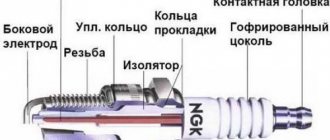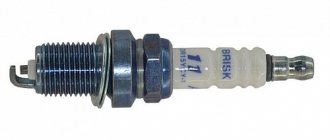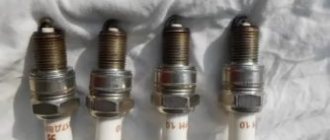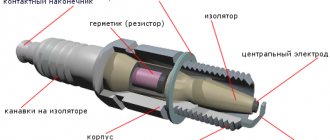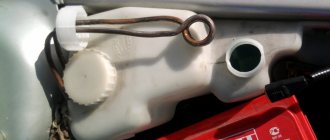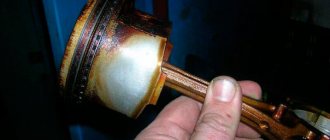Spark plugs are simple in design, highly durable and reliable, but their performance may decrease over time. Contamination of the electrodes occurs due to engine operation on low-quality fuel, incorrectly set ignition system, and during difficult starts in winter conditions. In this case, it becomes necessary to clean the spark plugs at home.
Types of candles
Manufacturers offer a large selection of these products.
It differs from each other in shape, recommended gap between the electrodes and the following parameters:
- number of electrodes - there are single- or multi-electrodes;
- heat number - candles are cold or hot;
- material of the central electrode.
The following types of spark plugs are currently available for purchase:
- Standard. It is characterized by low cost; here the central electrode is made of heat-resistant metal. It wears out relatively quickly, but due to its low cost, such products are always in demand. If the candle is of high quality, then it will fully exhaust its service life.
- Multielectrode. If in the previous version there is only 1 side electrode, then here there are from 2 to 4, which helps to increase the service life of the product. Multiple electrodes heat up more slowly than 1, and the lack of overheating increases the service life of these products. Although their cost is higher, their long service life and high reliability compensate for this disadvantage.
- Iridium and platinum. They received this name because of the material from which the central electrode is made. The use of iridium or platinum makes it possible to make it only 0.4-0.7 millimeters thick. Such products are distinguished by their long service life, it is 5-6 years or up to 200 thousand km. mileage Their only drawback is their high cost. The central electrode is also made from other materials (tungsten, yttrium, palladium), but such products are rarely found on sale.
Nickel option
Can it be cleaned with sandpaper? In principle, yes, why not. You just need to do it right. There is no need to rub the central and side electrodes until you are stupefied, just rub them a couple of times (“zero” and that’s it).
However, cleaning is often done a little differently. Use sandpaper to grind down both the central and side electrodes.
This is dangerous because the gap grows , let’s say it was 1 mm, but now it is 1.2 mm. You won’t feel the increase by eye, but for the ignition coils it will already be noticeable. As a result, the spark will not be as concentrated, and the engine will perform worse.
Checking the spark plugs
To determine the performance of the spark plug, it must be inspected. If it is working properly, then the electrodes should be light brown or yellow. If any deposits are found on the electrodes, they must be cleaned:
- Dry, black soot. This is caused by an incorrect proportion of the air-fuel mixture (enriched), malfunctions of the injection system, dirty air filter, malfunction of the lambda probe and temperature sensor. The thermal range of the spark plug must be chosen correctly; this is done in accordance with the recommendations of the motor manufacturer.
- Oily deposits. The reasons may be wear of the piston group, malfunction of the turbocharger (if there is one) and filling the engine with oil above normal.
- Varnish deposits of a yellowish or greenish tint. They indicate the presence of special additives in the fuel or oil.
- Resinous deposits. This is due to incomplete combustion of the additives present in the engine oil.
- Electrode melting. Occurs due to overheating of the spark plug caused by ignition failure, faulty valves, improper tightening, etc.
- White soot. It can be glossy, this indicates a lean mixture, insufficient engine cooling, early ignition, errors in choosing these elements. If the white coating is weak, this indicates the use of low-quality fuel; you also need to change the gas station where you refuel the car.
When to clean candles
If during inspection of the electrodes carbon deposits were found on them, then they must be cleaned. Based on a number of signs, you can understand that these elements need to be cleaned, even without the need to unscrew them from the engine:
- 1 or more cylinders do not work, the engine “troubles”;
- when starting to move, jerks appeared;
- engine power has decreased;
- dense bluish smoke comes from the exhaust pipe;
- engine starting has deteriorated;
- fuel consumption has increased.
Cleaning methods
You can use the services of a professional, but if you want to save money, you can clean the candles at home. This is done both with special equipment and with the use of available products available at home or purchased at the nearest store or pharmacy.
Using a sandblaster
This is a simple and effective method, but to implement it you will need a sandblasting device. The candle is screwed into the apparatus, which contains purified fine sand. Using compressed air, it is directed to the electrodes and effectively cleans them. There are small sandblasters that can be purchased at the store, and some craftsmen make such devices themselves.
Household chemicals
Although such products are not intended for cars, they can be used to quickly and efficiently clean spark plugs. Any active household chemical used for cleaning a kitchen stove, bathtub, toilet, etc. is suitable for this. The selected product is poured into a container and the working part of the element to be cleaned is immersed in it, after 20-30 minutes it is taken out, washed, the remaining carbon deposits are removed with a brush and dried.
Vinegar and soda
These 2 ingredients have been used to clean candles for a long time. They are placed either only in vinegar, or more soda is added to it. The contaminated elements are placed in the resulting solution for an hour, after which the softened deposits are removed and removed, and then dried, and they can be used again.
Thermal impact
Although this method helps remove deposits, it is dangerous because if the spark plug overheats, it can completely fail. To burn off the plaque, use heat using a gas burner, blowtorch or gas stove.
Heat until the electrodes turn crimson, then cool them slowly and clean them with a brush.
Ultrasonic method
To do this, you will need a container with a special solution and a device for emitting ultrasound. The method is highly effective, but few people have such equipment at home, so the method is most often used at service stations. The cost of ultrasonic cleaning is high, so it can only be used for expensive products.
Using sandpaper
This option is suitable if cleaning needs to be done in the field. Using sandpaper you can temporarily get rid of carbon deposits on the electrodes.
Soon, deposits will begin to accumulate in the resulting microcracks with even greater intensity.
Application of ammonium acetate
Using this method, we must remember that ammonium acetate vapor is harmful to humans. First, the candles are washed with gasoline and dried. Then a 20% ammonium acetate solution is poured into the container and heated to a boil. After this, remove from the heat and immerse the elements to be cleaned in the solution for 30 minutes. The treated products are taken out and cleaned with a stiff toothbrush, then washed with water and dried.
Digestion
Another popular method is to boil candles in a solution of washing powder or detergent. Do this for an hour, and then remove the remaining carbon deposits with a brush. This cleaning method does not damage the coating on the electrodes and allows you to effectively remove existing deposits, but it is time consuming.
other methods
In addition to household chemicals and vinegar, you can clean candles at home using sweet carbonated drinks (Pepsi-Cola, Fanta, etc.). They contain carbon dioxide and phosphoric acid, which soften any deposits, and they are easily removed with a brush. You can also deal with small deposits on the electrodes using a school eraser.
Now a popular option is to use Dimexide. This is a medical skin cleanser. Pour a little of this preparation into a glass and lower the candles into it so that their electrodes are completely covered. After 2-3 hours, they are taken out and the remaining deposits are removed with a toothbrush.
You can also use a solution of hydroperite. Dissolve 3-4 tablets of this product in 100 g of water and place candles there. Leave everything in a warm place for a day. Then the products to be cleaned are taken out, the remaining deposits are removed from their electrodes and dried.
Such chemical methods provide effective cleaning of carbon deposits without damaging the material of the electrodes and insulator.
Mechanical cleaning
For manual cleaning, a brush with stiff bristles, thin steel wire or nylon bristles is required. Even a toothbrush is enough. Be especially careful not to scratch the insulator. If this is not taken into account, the opposite effect can be achieved.
“Sandpaper” (“zero” sandpaper) or other hard materials are not suitable for the job. They cause scratches on the protective coating, which negatively affects the operation of the entire unit. You need to be especially careful with iridium plugs.
Sand cleaning at home is an excellent “imitation” of the sandblasting procedure in a workshop. Be sure to hold the spark plug in the socket of the electric drill. After switching on, the device should be immersed in the sandbox. You will need: a bucket of dry sand, an electric drill with reverse gear and the ability to work with it.
How to restore spark plugs
It is possible to repair (clean the electrodes) of the spark plug if various deposits have formed on its electrodes. If the central electrode is damaged (and this can be determined using a multimeter), then such an element cannot be restored. Cleaning is carried out both mechanically and chemically.
When using a metal brush or sandpaper, scratches appear on the electrode, in which carbon deposits soon accumulate again. The use of aggressive chemicals causes damage to the electrode coating and housing. A tried and true option is a sandblaster, but not every home garage has one.
When restoring a spark plug, be sure to check the gap between the electrodes. For carburetor and injection engines, as well as different brands of these products, it can be in the range of 0.7-1.5 mm. Before adjusting the gap, you need to find out what it should be in your case.
How the central entrance of the UAZ plant ended up underground
Once in Ulyanovsk, the first thing I did was rush to the UAZ. Imagine my surprise when I couldn’t find the central entrance the first time, even the second time. All because UAZ sold its buildings for optimization purposes. Moreover, these buildings still stand with the logos of the plant, but in fact they have long since had a new owner who rents out these premises for office purposes.
The first thing that catches your eye is the lack of free parking at the plant. All parking is paid. And those that are free are just on the lawn of residential buildings. So it’s better to come to the plant by tram.
The multi-storey Soviet building with the UAZ logo on the roof was once an engineering building. As I understand it, engineering has now been outsourced, so the building became unnecessary and was sold
Of great value is the old entrance gate, which was built in the 1950s. At the top, the retro logo and the “Automobile Plant” sign have been preserved. But the entrance is surrounded by a fence around the entire perimeter, and it no longer belongs to the plant. I hope that the inscriptions on top are not dismantled
And this is a gearbox for cars. So, where do ordinary workers come in?
The central entrance is located in the underground passage
The tunnel is not intimidating with its views. It is even branded with the symbols of the plant
The tunnel ends with a staircase that leads to the turnstiles.
Is this what the central entrance of a factory should look like? After all, this is the face of the plant!
On the Zen channel manikol you can read about the UAZ museum. Actually, to which I was heading
Prevention Tips
To ensure uninterrupted operation of spark plugs throughout the recommended service life, it is enough to follow simple rules:
- fill in high-quality gasoline, the octane number of which corresponds to the brand recommended by the car manufacturer;
- the brand of spark plugs must correspond to that recommended by the engine manufacturer;
- monitor the operation of the ignition and power systems and, if any malfunctions occur, immediately eliminate the malfunction;
Periodic inspection of spark plugs, as well as the correct selection and application of a method for cleaning them from carbon deposits will help increase the service life of these elements and ensure their trouble-free operation.
Home chemistry laboratory
Separately, I would like to consider several products that have shown themselves to be good. They really make it possible to quickly and effectively rid spark plugs of accumulated carbon deposits.
You just need to work with them extremely carefully, observing safety precautions.
- dimexide;
- acetic acid with soda;
- hydroperit.
Now let's go through them separately.

